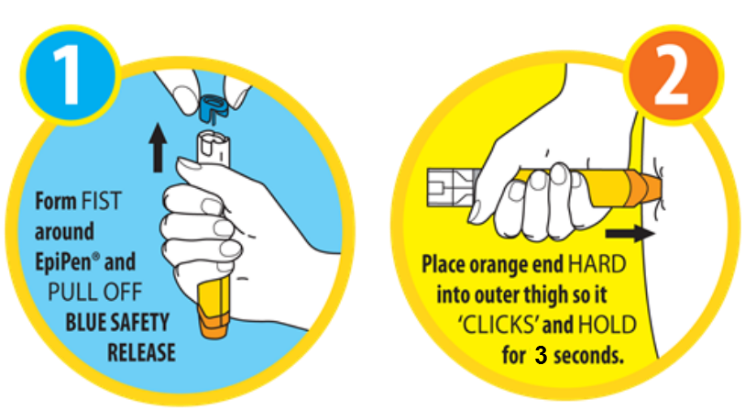Information for supporting a student having an Anaphylaxis event
If on a University of Chichester campus immediately call for a First Aider on 01243 816363 quoting your location, name and the name of the casualty if known and nature of the injury/event. If off campus seek support from a first aider where available and follow the information on the students support card.
The below information provides additional support for academics/students/members of the public and first aiders supporting a UoC student during an anaphylaxis event.
You will have most likely reached this link from QR code on the students individual Sunflower lanyard support card - please read this page in conjunction with the information on that card to fill any gaps in this documents generic information.
First aid Rapid Action Plan
Anaphylaxis
Main Signs and Symptoms. Not all need to be present.
• Itchy skin or a raised, red skin rash.
• Swollen eyes, lips, hands and feet.
• Feeling lightheaded or faint.
• Feeling panicky
• Swelling of the mouth, throat or tongue which can cause breathing and swallowing difficulties.
• Wheezing.
• Abdominal pain, nausea and vomiting.
• Collapse and unconsciousness.
ADMINISTER THE EPIPEN IMMEDIATELY AND WITHOUT DELAY, IF THE STUDENT DISPLAYS ANY SIGNS OF AN ANAPHYLACTIC REACTION
CALL AN AMBULANCE AS SOON AS POSSIBLE
To administer the EpiPen: [ other Autoinjector]
• The student should be able to administer the EpiPen independently, they may need reassurance or help retrieving the pen.
• If the student is too unwell or panicky the EpiPen will need to be administered by someone else. The instructions are clear, and it is not a difficult procedure.
• Ideally The student should be placed on their side in the recovery position, however, if their condition is deteriorating the EpiPen can be administered immediately.
• The pen contains a preloaded syringe containing the drug Adrenaline - there is a hidden needle in the orange end.
• Remove the pen from the packaging, hold in your fist and remove the blue safety cap from one end of the pen.
• Holding the pen at a right angle to the thigh, firmly press the orange injector tip of the pen against the middle, upper, outer, part of the student’s thigh muscle through any clothing. The injection site is usually at the outer seam area of trousers so be careful to avoid thick seams and pocket contents. Once you have placed the pen firmly into the thigh, there should be a clicking sound as the pen is activated. Hold the pen in position and count for at least 3 seconds to allow the injection to complete.
• Then remove the pen from the thigh, the orange tip will extend automatically and hide the needle for safety.
• Make a note of the time of administration
• The student should recover within a few minutes following the administration of Adrenaline.
• If the student’s symptoms do not improve within 5-10 minutes, a further EpiPen can be administered.
• In all cases call an Ambulance immediately after EpiPen admin
• The student must be taken to hospital to replace the EpiPens, to monitor for potential arrhythmias and to observe for a second reaction.
• Administer first aid whilst waiting, observe breathing, keep warm, and offer reassurance
Reduce exposure to Allergen if possible, check with student or Lanyard for allergens.
Consider washing exposed areas, removing sting, rinsing mouth if airway not compromised.
Instructions for calling an Ambulance:
If the student is unconscious:
• Call 999 for the ambulance service and ask for a paramedic ambulance immediately
• Inform them that the student is having an anaphylactic reaction.
• It is important to state “a paramedic” is needed, as they carry medication.
• Give the student’s location, room no in halls and the University address or other location if off campus.
• If on campus ensure 01243 816363 has been informed that an ambulance has been called and the location of the student, so that the ambulance can get to the student as soon as possible.
• Ask for a first aider to be sent to your location if not already present.
• Stay with the student at all times and ensure the student is kept as warm and comfortable as possible. Offer reassurance.
• If unconscious, place in the recovery position.
• Complete an incident form when appropriate.


